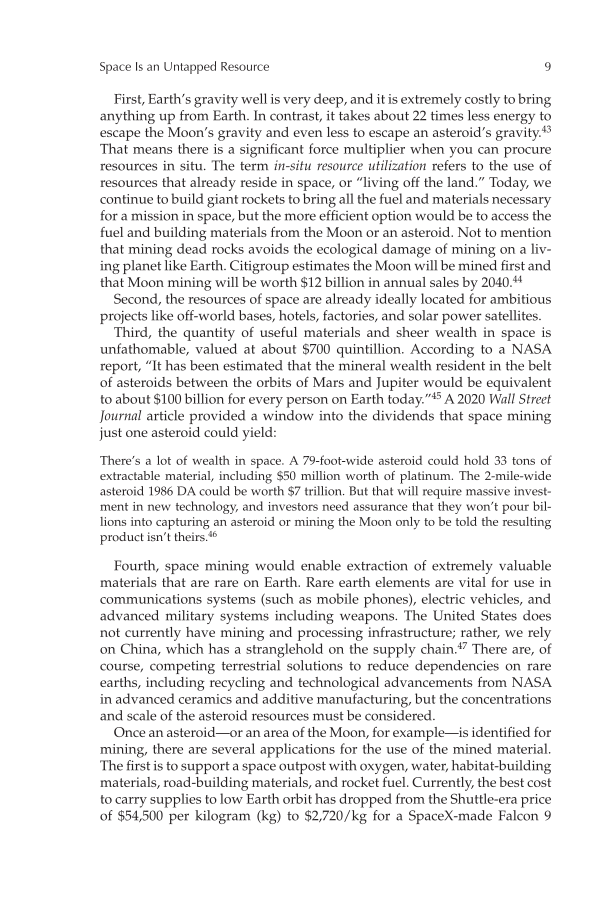Space Is an Untapped Resource 9 First, Earth’s gravity well is very deep, and it is extremely costly to bring anything up from Earth. In contrast, it takes about 22 times less energy to escape the Moon’s gravity and even less to escape an asteroid’s gravity.43 That means there is a significant force multiplier when you can procure resources in situ. The term in-situ resource utilization refers to the use of resources that already reside in space, or “living off the land.” Today, we continue to build giant rockets to bring all the fuel and materials necessary for a mission in space, but the more efficient option would be to access the fuel and building materials from the Moon or an asteroid. Not to mention that mining dead rocks avoids the ecological damage of mining on a liv- ing planet like Earth. Citigroup estimates the Moon will be mined first and that Moon mining will be worth $12 billion in annual sales by 2040.44 Second, the resources of space are already ideally located for ambitious projects like off-world bases, hotels, factories, and solar power satellites. Third, the quantity of useful materials and sheer wealth in space is unfathomable, valued at about $700 quintillion. According to a NASA report, “It has been estimated that the mineral wealth resident in the belt of asteroids between the orbits of Mars and Jupiter would be equivalent to about $100 billion for every person on Earth today.”45 A 2020 Wall Street Journal article provided a window into the dividends that space mining just one asteroid could yield: There’s a lot of wealth in space. A 79-foot-wide asteroid could hold 33 tons of extractable material, including $50 million worth of platinum. The 2-mile-wide asteroid 1986 DA could be worth $7 trillion. But that will require massive invest- ment in new technology, and investors need assurance that they won’t pour bil- lions into capturing an asteroid or mining the Moon only to be told the resulting product isn’t theirs.46 Fourth, space mining would enable extraction of extremely valuable materials that are rare on Earth. Rare earth elements are vital for use in communications systems (such as mobile phones), electric vehicles, and advanced military systems including weapons. The United States does not currently have mining and processing infrastructure rather, we rely on China, which has a stranglehold on the supply chain.47 There are, of course, competing terrestrial solutions to reduce dependencies on rare earths, including recycling and technological advancements from NASA in advanced ceramics and additive manufacturing, but the concentrations and scale of the asteroid resources must be considered. Once an asteroid—or an area of the Moon, for example—is identified for mining, there are several applications for the use of the mined material. The first is to support a space outpost with oxygen, water, habitat-building materials, road-building materials, and rocket fuel. Currently, the best cost to carry supplies to low Earth orbit has dropped from the Shuttle-era price of $54,500 per kilogram (kg) to $2,720/kg for a SpaceX-made Falcon 9
Document Details My Account Print multiple pages
Print
You have printed 0 times in the last 24 hours.
Your print count will reset on at .
You may print 0 more time(s) before then.
You may print a maximum of 0 pages at a time.


















































































































































































































































